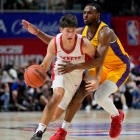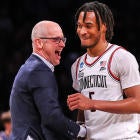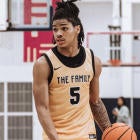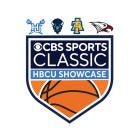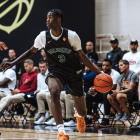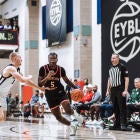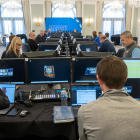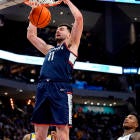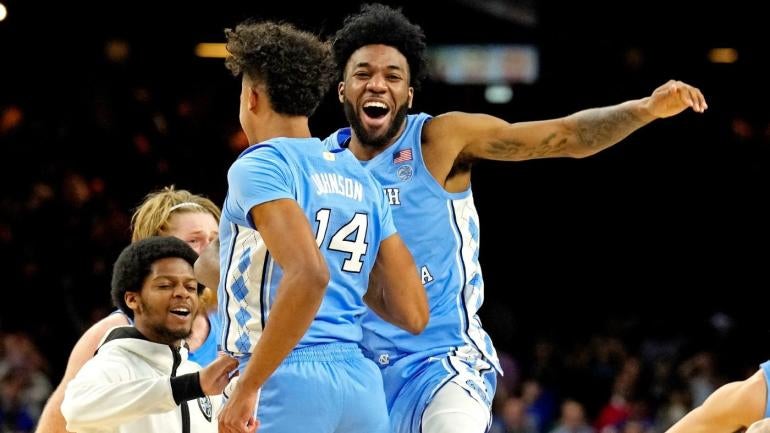
One of the most exciting parts of college basketball is the unknown. While the AP Top 25 usually provides some guidance, it's a lot of guesswork and very difficult to predict given the roster churn year-over-year.
Some cores have spent three years together; others have spent three months. Weighing the proven floor of an experienced team against the seemingly limitless potential of a new, talented bunch is no easy task.
Still, the top-ranked teams are there for a reason. Each of the last five national champions were ranked in the top 10 entering the season. So, among this year's top 10, what stands out? What questions are there to answer? Let's take a look.
1. North Carolina Tar Heels
Big question: Who steps up off the bench?
Throughout the latter half of last season and especially in the NCAA Tournament, North Carolina relied almost exclusively on its "Iron Five" -- starters Caleb Love, RJ Davis, Leaky Black, Brady Manek and Armando Bacot. That five nearly carried the Tar Heels to a title, and four of them are back, with highly regarded Northwestern transfer Pete Nance likely filling Manek's role.
North Carolina finished 348th out of 358 Division I teams in KenPom.com's bench minutes metric last season, and its 13.4 bench points per game ranked outside the top 300 nationally as well. Puff Johnson, the younger brother of former Tar Heel and current Phoenix Suns forward Cameron Johnson, can play both forward spots and showed promise late last year, including 11 points in the title game. Fellow forward Justin McKoy also returns.
More question marks come elsewhere along the bench. Are Dontrez Styles and D'Marco Dunn -- two top-100 recruits in 2021 -- ready to contribute in the backcourt? What about Seth Trimble, the No. 30 overall prospect in 2022 according to 247Sports? There must be answers for North Carolina to live up to its preseason ranking.
2. Gonzaga Bulldogs
Big question: How does the point guard picture play out?
Gonzaga has evolved into one of the best and most consistent programs over the past few years, and no matter their roster composition, one thing stays the same: strong point guard play. Nigel Williams-Goss. Josh Perkins. Jalen Suggs. Andrew Nembhard. You name it, the Bulldogs have had it. Now that responsibility belongs to Nolan Hickman.
Hickman had some nice moments last season but is ultimately pretty untested in high-leverage situations. In fact, Nembhard played all but three minutes of the team's final six games. With Drew Timme, Julian Strawther and Rasir Bolton returning and Malachi Smith and Efton Reid incoming, there's plenty of firepower -- if Hickman can effectively lead the attack.
3. Houston Cougars
Big question: Who provides shot creation?
We generally know what Houston is: an elite rebounding team, extremely tough on both ends with a ton of depth. The Cougars return a lot from last year's Elite Eight squad, led by preseason All-America selection Marcus Sasser. And while Houston's offensive efficiency numbers have been strong during their recent rebirth under Kelvin Sampson, their shooting woes often haunt them at the worst time. See 44 points on 30% shooting (including 5% from deep) in the Elite Eight loss to Villanova.
This season, there's freshman star Jarace Walker, a springy, skilled big with an emerging face-up game and Houston's highest-ranked commit in the 247Sports era. In the backcourt, there's another freshman, Terrance Arceneaux, whom CBS Sports college basketball insider Matt Norlander describes as "a potential future NBA player." As for veteran backcourt options, there's Tramon Mark, who appeared in just seven games last year due to a shoulder injury, and Jamal Shead, a double-digit scorer last year. There is no shortage of potential options. Who delivers?
4. Kentucky Wildcats
Big question: Is there enough outside shooting?
John Calipari's rosters certainly have some tendencies, and this one is no different. Active, athletic bigs who love to rim run, protect the paint and rebound? Check. Naismith National Player of the Year Oscar Tshiebwe is back. So are Jacob Toppin, Lance Ware and Daimion Collins. A loaded recruiting class? Check. Kentucky's 2022 class was fifth in the nation according to 247Sports, led by five-stars Cason Wallace and Chris Livingston.
Potentially iffy shooting that Calipari hopes to solve with transfers? Check. Last year, it was Kellan Grady who was a bellwether for the Wildcats' success. He averaged 12.3 points in wins and shot 44.9% from 3-point range in wins. Those numbers were 8.2 and 31.5% in losses. The year before was Davion Mintz. This year, it could be CJ Fredrick (career 46.6% 3-point shooter at Iowa, missed last year with hamstring injury) and Antonio Reeves (20.1 ppg on 39% 3-point shooting last year at Illinois State). Regardless, Kentucky needs shooting. Over the last three seasons, only Mississippi State averages fewer 3-pointers per game in the SEC.
T-5. Kansas Jayhawks
Big question: Is the next standout post player currently on the team?
Though Ochai Agbaji and Christian Braun were both first-round NBA Draft picks, David McCormack was the key cog in Kansas' offense last season. The senior big man led the team in usage rate for the second straight campaign, posted the fifth-highest offensive rebounding rate in the nation and, fittingly, scored the final four points of the national championship game. He leaves huge shoes to fill, and the potential options to fill them are mostly unknowns.
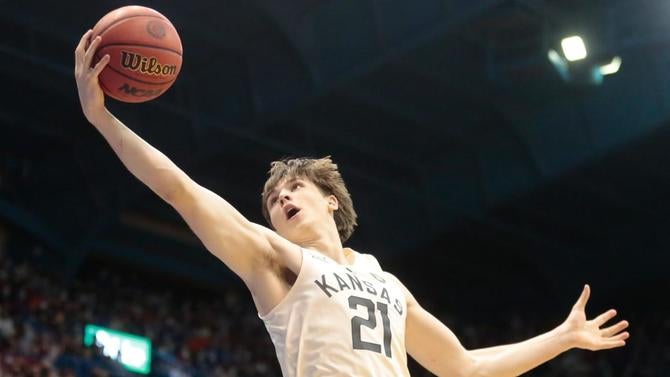
Zach Clemence may get the first crack. The talented sophomore didn't see much action last season behind McCormack and Mitch Lightfoot, but his recruiting credentials and year of experience help. Talented freshmen Ernest Udeh Jr. and Zuby Ejiofor may be counted on, too. Historically, Bill Self has had the luxury of overlapping his standout big men. McCormack played behind Udoka Azubuike, and there was Landen Lucas to cover a couple of years between Perry Ellis' departure and Azubuike's emergence. This year, his bigs will have to learn on the fly.
T-5. Baylor Bears
Big question: Will the Bears have enough versatile depth?
Having good depth is great; having versatile depth is what's elevated Baylor to among college basketball's elite. Scott Drew's rotation, when healthy, has been nine-deep, often with all nine providing a little something different. Look at the 2020-21 national championship team, and you'll see terrific guards, plenty of shooting and wings and bigs that fill a variety of roles.
This year, there should be great guard play by veterans Adam Flagler, LJ Cryer and newcomer Keyonte George, the third highest-rated recruit in Baylor history. In the frontcourt, Flo Thamba and Jonathan Tchamwa Tchatchoua are back to provide defense and energy. But following the departures of Matthew Mayer (transfer), Kendall Brown (NBA Draft) and Jeremy Sochan (NBA Draft), Baylor's wing depth and versatility will be tested. In a perfect world, transfers Caleb Lohner (BYU) and Jalen Bridges (West Virginia) fill those departures seamlessly, but that's far from a guarantee.
7. Duke Blue Devils
Big question: How quickly and how well do all the new pieces mesh?
When one of the greatest coaches of all time retires and is replaced by a first-time head coach who takes over a very new roster, the questions aren't necessarily stats driven. It's whether it can all work out.
Per usual, Duke has a ton of talent. Not per usual, it's Jon Scheyer figuring out how to make it work, not Mike Krzyzewski. There are 10 new faces who could contribute to the rotation and, potentially, a little overlap at several spots. Duke brought in four centers alone this offseason, with top-five recruits Dereck Lively II and Kyle Filipowski joining fellow freshman Christian Reeves and Northwestern transfer Ryan Young. In the backcourt, Jeremy Roach is the lone prominent returner, and he's joined by a bevy of young talent. Dariq Whitehead -- yet another top-five recruit -- headlines the wing group. There are plenty of pieces; sorting them all out and making them work together will likely be a months-long process.
8. UCLA Bruins
Big question: Can Jaime Jaquez Jr. carry the load offensively?
There are high expectations for Jaquez Jr. this season. He was voted to the CBS Sports Preseason All-America Team, and he should become the offensive focal point of one of the best teams in the nation. Is he capable of carrying the load? With Johnny Juzang and Jules Bernard gone, we're about to find out.
Jaquez Jr.'s shooting numbers fell both inside (53 to 52.2%) and outside (39.4 to 27.6%) the arc last season. That's the bad news. The good news is his free throw percentage went up, his assist rate went up, his turnover rate went down and, in three full games without Juzang, he averaged over 20 points per game. At his best, Jaquez Jr. is an offensive force who gets to his spots at will and can step out and knock down 3-pointers. UCLA will need him to be at his best this year.
9. Creighton Bluejays
Big question: Can the Bluejays make enough 3-pointers?
Entering last season, Creighton had been the best 3-point shooting team in Division I over the prior decade. Last season, the Bluejays shot a putrid 30.8% from 3-point range, the worst number in school history and outside the top 300 in Division I. That they still made the NCAA Tournament speaks volumes to just how good they were elsewhere.
This season, Creighton adds one of the best scorers in the country in South Dakota State transfer Baylor Scheierman. who can absolutely drill it from deep (46.9%) and really score from all over, but he'll need others to step up. Promising sophomores Ryan Nembhard and Arthur Kaluma are prime candidates, and TCU transfer Francisco Farabello is a very good shooter as well. If the Bluejays are to live up to their highest preseason AP Poll ranking ever, they'll have to shoot it much, much better from deep.
10. Arkansas Razorbacks
Big question: How will the backcourt shake out?
Just like Duke, Arkansas has 10 new faces all competing for playing time this year and a key guard (in this case Davonte Davis) leading the way among returners. The backcourt will be particularly intriguing with McDonald's All-Americans Nick Smith Jr. and Anthony Black joining Davis. The Razorbacks had an eye-opening 23 turnovers in last week's 30-point exhibition loss at Texas, and that number shows the difference between an experienced Longhorns team that has played a lot together and a fresh-faced Arkansas team that simply hasn't.
How Eric Musselman uses and rotates his guards will be fascinating. Smith Jr. is an absurdly talented scorer who can create for others while Black is more of a true point guard. Davis, meanwhile, is the only one of the three who has any college experience, and he should once again be a big part of things, even if it's mostly off the bench. Can those three play together? Can Smith Jr. and Davis share the court? Which one emerges as a true secondary ball handler? Like Duke, Arkansas may need some time to figure out the answers.










